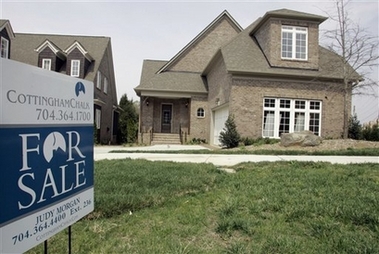Home prices worst since '94 in US
(AP)Updated: 2007-03-28 13:55
NEW YORK - Prices of single-family homes across the nation depreciated in January compared to a year ago, the worst results in more than 13 years, a housing index released Tuesday by Standard & Poor's showed.
 A new home is advertised for sale in Charlotte, N.C., Monday, March 26, 2007. [AP]  |
The S&P/Case-Shiller composite index showed a drop of 0.7 percent from a year ago in the price of a single-family home based on existing homes tracked over time in 10 metropolitan markets. In January 1994 the index dropped by 0.9 percent compared to January 1993, S&P said.
For its 20-city composite index, prices fell 0.2 percent. That data has been collected since 2001.
Government sales figures reported Monday showed that the number of home sales in February fell to the lowest level in seven years, and followed an even larger drop of nearly 16 percent in January.
On a year-over-year basis, eleven of the 20 cities in the S&P index show negative annual returns in their prices.
All cities in the survey, except for Charlotte, N.C., showed either flat or negative returns in January when compared to December.
MacroMarkets LLC Chief Economist Robert Shiller said the composites clearly show the "dire" state of the real estate market across the nation.
"The dismal growth in the 10-city composite is now at rates not seen since January 1994," Shiller said in a statement.
The downward trend is reflected in data across the nation while certain cities such as San Diego, Detroit, Boston, Phoenix and Tampa, Fla., have done worse. Seattle and Portland, Ore., meanwhile, show some resistance to the downturn.
Federal Reserve governors watch housing as one of the most important indicators of the health of the overall economy. Economists fret that the slump in housing will drag down growth as the slowdown affects consumer spending and the construction industry.
Last Wednesday, Fed governors held the benchmark interest rate in place at 5.25 percent, meaning that the prime interest rate used by commercial banks will stay at 8.25 percent. It was the sixth meeting in a row the Fed has held steady.
On Monday, the Commerce Department reported that sales of new single-family homes fell 3.9 percent in February to a seasonally adjusted annual rate of 848,000, the slowest sales pace in nearly seven years. The February decline followed an even larger 15.8 percent drop in sales in January, which had been the largest one-month plunge in 13 years, another sign the market has not yet found a bottom.
|
||
|
||
|
|